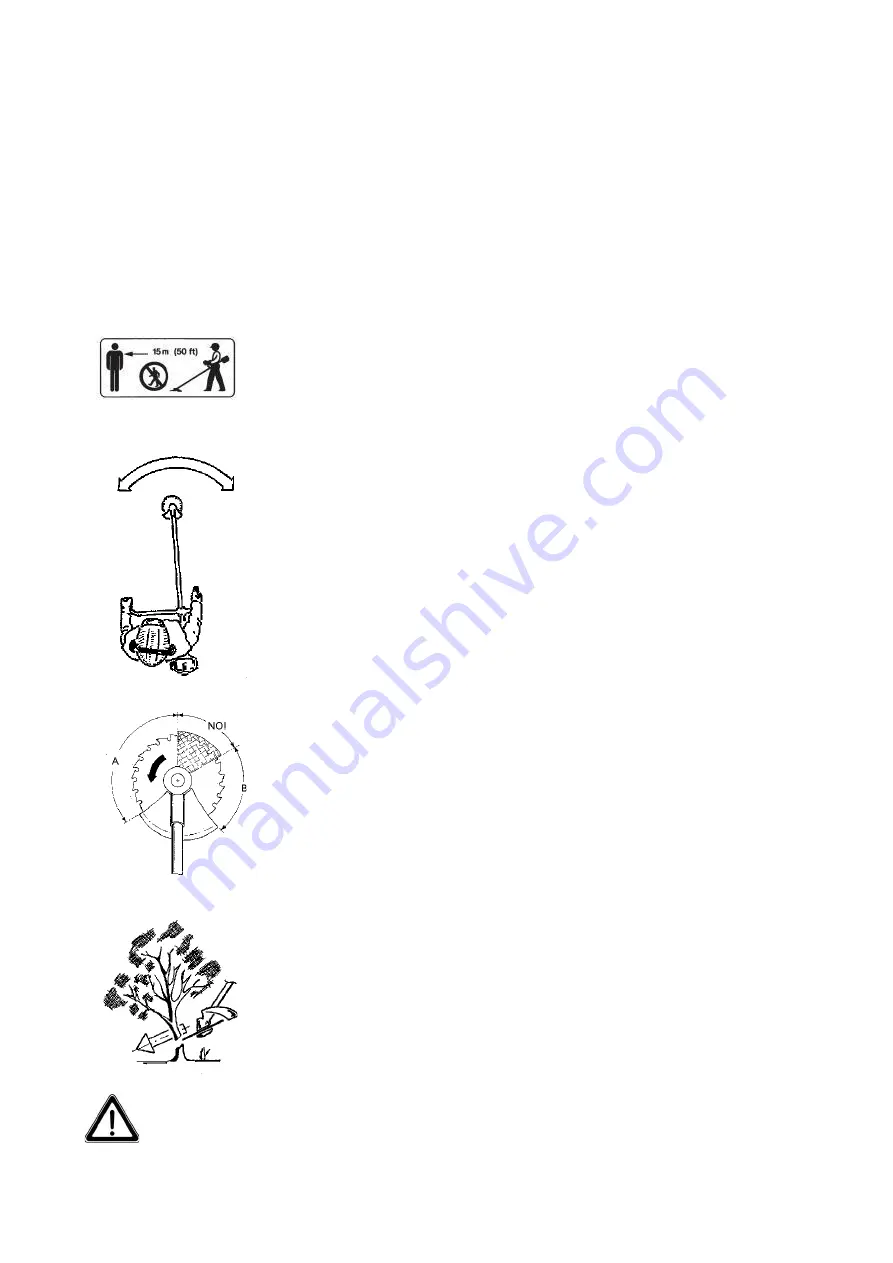
INSTRUCTIONS FOR THE USE OF THE BRUSH-CUTTER
4.3
Correct use
The brushcutter must be used only to cut grass, bushes and shrubbery (trunks with a max. diameter of 200 mm can be
cut using a machine with elevated power equipped with both a blade and a trunk-retainer guard to CE standards).
•
Wear the safety belts and adjust them to your height.
•
After the engine has started, let it run for 2-3 minutes at the minimum level.
•
Connect the brushcutter to the safety quick release clip on the safety belts, or if the brushcutter has been provided in
the backpack version, wear it on your shoulders.
•
Make sure that the weight of the machine is evenly distributed and perfectly balanced in such way that the cutting
organ is parallel to the ground and does not require support from the grip.
•
Perform a few accelerations (without reaching the maximum rpm) without doing work to make sure that everything
is functioning regularly.
•
With the cutting tool stationary in clear sight and constantly under your control, reach
the work position by carrying the machine beneath the level of your waist far away
from your body, making sure that there are no other people within a 15 meter radius.
4.4
Use of the machine
Fig.21
Fig.22
Fig.23
Assume a stable and balanced position on both feet.
Grass is cut
as if operating in corridors 1.5 meters wide by moving forward step by step
and swinging the machine right and left. Make sure that you are standing securely on both
feet before taking a new step (Fig. 21). When using the grass-cutter disks, always cut
from right to left and leave a pile of cut grass on the left for subsequent recovery.
When using the machine to cut bushes or pruning
mount the CE-standard disk saw
together with the appropriate safety guard. You will reach the maximum cutting capacity
when the acceleration of the machine is at its peak rpm and consequently the saw will
have a lower probability of jamming or stopping under these operating conditions. In
order to use this type of cutting tool correctly, the blade must not be used in its critical
sector (Fig. 22), given the risk of the blade’s rebounding (known kick-back). This effect is
sometimes strong enough to make you lose control of both the machine and your balance,
with the consequent risk of injury. We recommend cutting with side A of the disk saw for
ideal cutting control. Side B can also be used for cutting, but there is less control because
of the disk counter-clock-wise rotation.
The direction of the felling
of the trunk depends on the sector of use of the disk saw, a
determined inclination of the blade, and the diameter of the trunk in question.
-
For trunks of up to 3 cm in diameter, the disk saw can be used with “hatchet strokes”, in
other words, cutting from the opposite side foreseen for the falling of the trunk.
-
For trunks of from 3 to 7 cm in diameter, the disk saw must never be held horizontally,
but always at a slight angle from upwards downwards to prevent the blade from jamming.
The thicker the diameter of the trunk, the greater this inclination must be (Fig. 23).
-
Trunks of more than 7 cm in diameter can be also felled with high-power brushcutter,
but this operation should be performed only occasionally because a power saw is more
appropriate in cases such as these.
Try to avoid even the smallest stones, piles of earth, small pieces of wood, and any other
hidden objects in the grass. If you happen to strike some large object, if the cutting tool
suddenly jams due to overloading, if too much grass, stringy vegetal matter or bark gets
wound up inside the machine, reduce the speed to the minimum and then disengage the
clutch.
Make sure that the blade (which turns through inertia) has come to a halt, otherwise stop it
against the ground in a safe place and then switch off the engine. Unhook the brushcutter
from the safety belt and position it on the ground in order to make sure that the cutting
tool has not undergone any damage, such as the cracking/ breakage of teeth, etc., and
replace if required. If the tool has got tangled up in stringy vegetal matter, put on a pair of
gloves and use the correct utensil to completely remove all the tangled material.
ALL T
OPERA
HE MACHINE’S SAFETY SYSTEMS AND EQUIPMENT MUST BE MAINTAINED IN
TION ALL THROUGHOUT USE.
GB - 16
Summary of Contents for BBH 2600
Page 39: ......






































